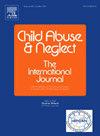School closures, child maltreatment reporting and victimization during the pandemic
IF 3.4
2区 心理学
Q1 FAMILY STUDIES
引用次数: 0
Abstract
Background
School closures during the pandemic correlated with declines in child maltreatment reports in the U.S. However, it remains unclear how reporting from personnel other than schoolteachers or nurses and the nature of these reports were affected.
Objective
To examine the effect of school closures on child maltreatment reports by reporting source, maltreatment type, and likelihood of victimization as the pandemic evolved.
Participants and setting
Child maltreatment reporting in the U.S. from January 2018 to May 2022.
Methods
Linking child file data from the National Child Abuse and Neglect Data System with school closure data from the U.S. School Closure & Distance Learning Database, we estimate the effect of school closures on county-month level child maltreatment reports by reporting source and maltreatment type. We also examine the effect on individual-level likelihood of victimization over three phases (January 2018–February 2020, March 2020–May 2021, and August 2021–May 2022).
Results
The county-month level models show that school closures negatively affected reporting across all sources and maltreatment types. The child-report level models suggest that school closures were associated with an increased likelihood of victimization. The effects of school closures and maltreatment risk factors (e.g. caregiver domestic violence) did not weaken as the pandemic waned.
Conclusions
This study adds nuance to the understanding of child maltreatment trends in relation to school closures and other factors throughout the pandemic. It is crucial to enhance reporting through alternative methods. Strategies targeting domestic violence and inadequate housing may be more effective in reducing and preventing child maltreatment.
大流行期间学校关闭、儿童虐待报告和受害情况。
背景:大流行期间学校关闭与美国儿童虐待报告的下降相关。然而,目前尚不清楚学校教师或护士以外的人员报告以及这些报告的性质是如何受到影响的。目的:通过报告来源、虐待类型和随着疫情发展受害的可能性,研究学校关闭对儿童虐待报告的影响。参与者和环境:2018年1月至2022年5月期间美国儿童虐待报告。方法:将来自国家儿童虐待和忽视数据系统的儿童档案数据与来自美国学校关闭和远程学习数据库的学校关闭数据联系起来,我们根据报告来源和虐待类型估计学校关闭对县月级儿童虐待报告的影响。我们还研究了三个阶段(2018年1月至2020年2月,2020年3月至2021年5月和2021年8月至2022年5月)对个人层面受害可能性的影响。结果:县月级模型显示,学校关闭对所有来源和虐待类型的报告产生了负面影响。儿童报告水平模型表明,学校关闭与受害的可能性增加有关。学校关闭和虐待风险因素(如照料者家庭暴力)的影响并未随着疫情的减弱而减弱。结论:这项研究增加了对整个大流行期间与学校关闭和其他因素相关的儿童虐待趋势的细微理解。通过替代方法加强报告是至关重要的。针对家庭暴力和住房不足的战略在减少和防止虐待儿童方面可能更为有效。
本文章由计算机程序翻译,如有差异,请以英文原文为准。
求助全文
约1分钟内获得全文
求助全文
来源期刊

Child Abuse & Neglect
Multiple-
CiteScore
7.40
自引率
10.40%
发文量
397
期刊介绍:
Official Publication of the International Society for Prevention of Child Abuse and Neglect. Child Abuse & Neglect The International Journal, provides an international, multidisciplinary forum on all aspects of child abuse and neglect, with special emphasis on prevention and treatment; the scope extends further to all those aspects of life which either favor or hinder child development. While contributions will primarily be from the fields of psychology, psychiatry, social work, medicine, nursing, law enforcement, legislature, education, and anthropology, the Journal encourages the concerned lay individual and child-oriented advocate organizations to contribute.
 求助内容:
求助内容: 应助结果提醒方式:
应助结果提醒方式:


